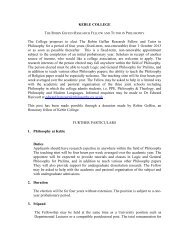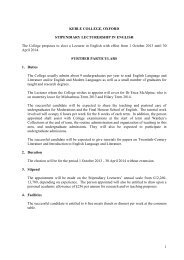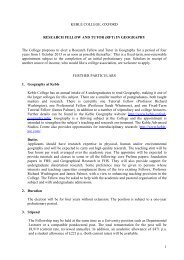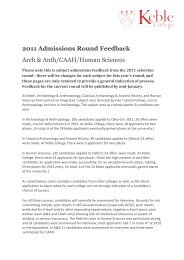The Record 2009 - Keble College - University of Oxford
The Record 2009 - Keble College - University of Oxford
The Record 2009 - Keble College - University of Oxford
Create successful ePaper yourself
Turn your PDF publications into a flip-book with our unique Google optimized e-Paper software.
<strong>Keble</strong> <strong>College</strong>: <strong>The</strong> <strong>Record</strong> <strong>2009</strong><br />
have had its anatomy and development described in complete<br />
cellular detail. Its genome is only one thirtieth the size <strong>of</strong> the<br />
human genome and was completely sequenced ten years ago,<br />
partly as a pilot for the subsequent and much larger human<br />
genome project. Now we would like to know what all its genes<br />
are doing. But there is a surprise here: the worm has far more<br />
genes than seem necessary to create and sustain such a simple<br />
creature. In fact, C. elegans has over 20,000 genes, almost as<br />
many as the 25,000 currently estimated as the number <strong>of</strong><br />
human genes. What are they all doing? We can begin to answer<br />
this question by making use <strong>of</strong> an extraordinary effect called<br />
RNA interference (RNAi for short) which was first discovered<br />
in C. elegans and then found to be universal among plants and<br />
animals. RNAi provides a convenient means <strong>of</strong> reducing the<br />
activity <strong>of</strong> any chosen gene in an organism. It is ridiculously<br />
easy to implement in C. elegans, and the method has allowed<br />
several research teams to examine the effect <strong>of</strong> inhibiting, one<br />
by one, most <strong>of</strong> the 20,000 genes. Sometimes this inhibition<br />
results in death, sterility or deranged development, if the gene<br />
is important enough, but most <strong>of</strong> the time nothing happens.<br />
Yet evolution has preserved these apparently useless genes.<br />
We know this, because we can almost always find exactly<br />
the same gene in related species <strong>of</strong> nematode, which diverged<br />
from C. elegans many millions <strong>of</strong> years ago. Genes that aren’t<br />
useful get rapidly lost, over such periods <strong>of</strong> evolutionary<br />
time. So it is likely that the superficially non-functional genes<br />
are actually very important in the real life <strong>of</strong> the worm, out<br />
there in the complex soil ecosystem that it naturally inhabits.<br />
This is <strong>of</strong> course a much more challenging environment than<br />
a comfortable Petri dish. Indeed, when we repeat the RNAi<br />
experiments on certain genes, but add in pathogenic bacteria<br />
at the same time, we find that some <strong>of</strong> the genes that are<br />
dispensable for life in a protected environment are actually<br />
necessary to provide defence against the pathogen.<br />
Those are genes that are specialized for defence, but some<br />
<strong>of</strong> the other genes we study turn out to have roles both in<br />
immunity and in developmental processes. One <strong>of</strong> the pleasures<br />
<strong>of</strong> pursuing research is how <strong>of</strong>ten the investigation <strong>of</strong> one<br />
problem gives rise unexpectedly to an insight in a different area,<br />
and this has happened repeatedly during our investigations<br />
<strong>of</strong> worm immunity. Immunity and development seem to be<br />
strongly interwoven. <strong>The</strong>se crossovers also lead us to look at the<br />
organism in a more holistic way than we used to. Fortunately<br />
so much is known about the molecular and cellular biology<br />
<strong>of</strong> C. elegans that it is becoming increasingly possible to view it<br />
holistically, rather than as a collection <strong>of</strong> many different parts<br />
16
















